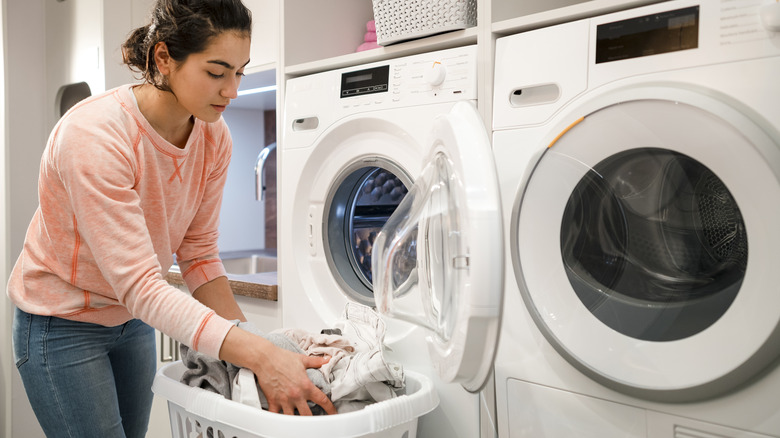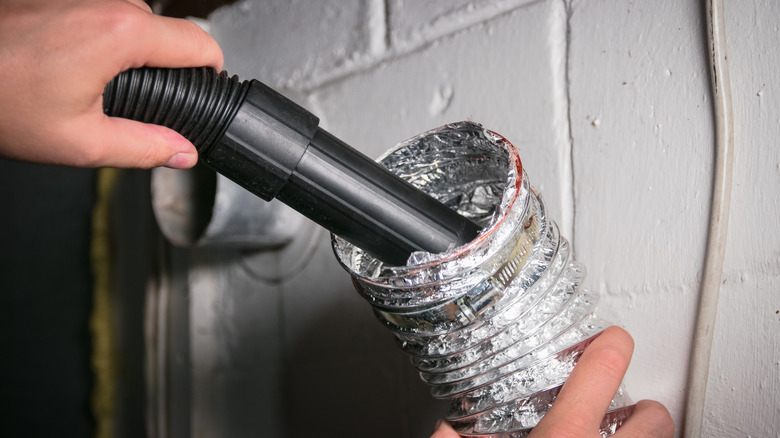Why Your Laundry Is Still Wet After A Dryer Cycle
Compared to a century ago, it seems that laundry is much easier thanks to modern appliances. Yet, it can be frustrating to work through your laundry pile only to find out that the dryer didn't quite dry everything. There can be multiple reasons why your laundry is still wet after a dryer cycle, including overloading the dryer or using the wrong drying program. However, one of the most common explanations is that there's a problem with the dryer's airflow, such as from a blocked lint screen or clogged vent. First, check and see if you may have forgotten to empty the lint trap and see if that fixes the problem on the next cycle.
Lint traps are essential to dryers as they help with airflow, circulating warm air, and catching lint that would otherwise go into the dryer vent. A clogged lint trap creates slower air circulation as your dryer works harder and longer to push the hot air through your clothes. Newer dryers may feature a lint trap indicator, but older models can lack this feature, and it's easy to forget to empty it during a busy day. To clean your lint trap, remove it from your dryer, then take off the lint with a toothbrush and by hand. Use a vacuum around the trap's enclosure for stray lint. You can also give the filter a gentle scrub with hot water and dish soap, then let it air dry. If your clothes still don't dry properly, then you may need to take other steps.
You may have a clogged dryer vent
The issue could be with your dryer vent, or duct, a tube which vents outside. The dryer vent helps remove moisture and lint as your clothes dry, but if it's blocked, it can affect your appliance's performance. This poor ventilation is one of the most common causes dryer issues, such as failure to adequately dry clothes. A blocked dryer vent is also a serious fire hazard, so proper maintenance is important (via U.S. Consumer Product Safety Commission). Luckily, cleaning your dryer vent is easy. Just wear protective gloves and have good ventilation before you work.
If you have a gas dryer, you should call in a professional to avoid a gas leak. For electric appliances, the process is a bit easier. Start by unplugging your dryer, then locate the vent. It might help to slide the machine back slightly for easier access. Remove the vent by using a screwdriver to remove any hardware fastening it to the dryer. Using a long vacuum hose, vacuum out the vent to remove any debris, such as lint and other material. You can also purchase vent brushes to make the process easier. Once satisfied with the duct's cleanliness, you can reconnect it, plug it back in, and move the dryer back to its original spot. You may need to do the same process outside at the exterior vent, or call a professional or your building's maintenance company if the problem persists.
Other reasons why your clothes are still wet
If the problem persists, you should check into other reasons for why your clothes don't properly dry, such as making sure you have the right dryer setting, especially if you use a sensor dry option. Ensure you choose the correct load setting, as heavier loads require a higher dry setting. Strive for a balanced load each time you run your dryer. If you have a mixed load of heavier fabrics, such as denim or large blankets mixed with lighter clothes, it can throw off the drying sensor. The sensor may only sense the lighter fabric, falsely detecting that everything is dry, while the heavier fabrics are still wet.
Practice appropriately loading, including noticing if the clothes can move freely during the cycle for proper airflow and making sure you don't overload your dryer, as these scenarios make your dryer have to work harder to heat and dry. You should also use your washer's spin cycle to help remove excess moisture before you dry your clothes, and unwind them if they are tangled, shaking them as needed, to help the air circulate smoother.


